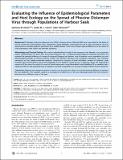Files in this item
Evaluating the influence of epidemiological parameters and host ecology on the spread of phocine distemper virus through populations of harbour seals
Item metadata
| dc.contributor.author | Harris, Catriona M | |
| dc.contributor.author | Travis, J.M.J | |
| dc.contributor.author | Harwood, John | |
| dc.date.accessioned | 2010-10-25T09:17:17Z | |
| dc.date.available | 2010-10-25T09:17:18Z | |
| dc.date.issued | 2008-07 | |
| dc.identifier | 416568 | |
| dc.identifier | bea313ed-a846-479b-bf4c-54a69c3d0387 | |
| dc.identifier | 50549098296 | |
| dc.identifier.citation | Harris , C M , Travis , J M J & Harwood , J 2008 , ' Evaluating the influence of epidemiological parameters and host ecology on the spread of phocine distemper virus through populations of harbour seals ' , PLoS ONE , vol. 3 , no. 7 , e2710 . https://doi.org/10.1371/journal.pone.0002710 | en |
| dc.identifier.issn | 1932-6203 | |
| dc.identifier.other | standrews_research_output: 25948 | |
| dc.identifier.other | ORCID: /0000-0001-9198-2414/work/60887674 | |
| dc.identifier.uri | https://hdl.handle.net/10023/1112 | |
| dc.description | Catriona Harris was supported by a grant from the UK Natural Environment Research Council. The funders had no role in study design, data collections and analysis, decision to publish, or preparation of the manuscript. | en |
| dc.description.abstract | Background: Outbreaks of phocine distemper virus (PDV) in Europe during 1988 and 2002 were responsible for the death of around 23,000 and 30,000 harbour seals, respectively. These epidemics, particularly the one in 2002, provided an unusual opportunity to estimate epidemic parameters for a wildlife disease. There were marked regional differences in the values of some parameters both within and between epidemics. Methodology and Principal Findings: We used an individual-based model of seal movement that allowed us to incorporate realistic representations of space, time and animal behaviour into a traditional epidemiological modelling framework. We explored the potential influence of a range of ecological (foraging trip duration, time of epidemic onset, population size) and epidemiological (length of infectious period, contact rate between infectious and susceptible individuals, case mortality) parameters on four readily-measurable epidemic characteristics (number of dead individuals, duration of epidemic, peak mortality date and prevalence) and on the probability that an epidemic would occur in a particular region. We analysed the outputs as if they were the results of a series of virtual experiments, using Generalised Linear Modelling. All six variables had a significant effect on the probability that an epidemic would be recognised as an unusual mortality event by human observers. Conclusions: Regional and temporal variation in contact rate was the most likely cause of the observed differences between the two epidemics. This variation could be a consequence of differences in the way individuals divide their time between land and sea at different times of the year. | |
| dc.format.extent | 175704 | |
| dc.language.iso | eng | |
| dc.relation.ispartof | PLoS ONE | en |
| dc.subject | QL Zoology | en |
| dc.subject | QH301 Biology | en |
| dc.subject | SDG 3 - Good Health and Well-being | en |
| dc.subject.lcc | QL | en |
| dc.subject.lcc | QH301 | en |
| dc.title | Evaluating the influence of epidemiological parameters and host ecology on the spread of phocine distemper virus through populations of harbour seals | en |
| dc.type | Journal article | en |
| dc.contributor.institution | University of St Andrews. School of Biology | en |
| dc.contributor.institution | University of St Andrews. Sea Mammal Research Unit | en |
| dc.identifier.doi | https://doi.org/10.1371/journal.pone.0002710 | |
| dc.description.status | Peer reviewed | en |
| dc.identifier.url | http://www.scopus.com/inward/record.url?scp=50549098296&partnerID=8YFLogxK | en |
| dc.identifier.url | http://www.plosone.org/doi/pone.0002710 | en |
This item appears in the following Collection(s)
Items in the St Andrews Research Repository are protected by copyright, with all rights reserved, unless otherwise indicated.

